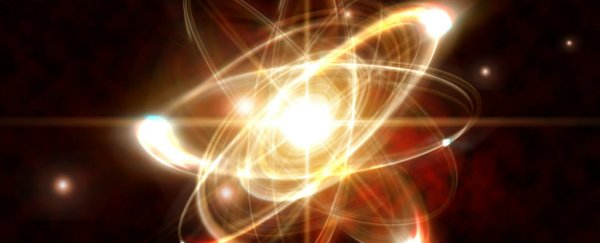When you shoot neutrons at a big atom, eventually one will collide with it just right, causing it to split into two smaller atoms and some more neutrons, while releasing a whole bunch of energy. This process of splitting big atoms into smaller atoms is known as nuclear fission, and if the neutrons happen to strike more atoms and repeat the process, there's a cascade of energy that, depending on your inclination, can either power a city or blow it to smithereens.
This we know, but as humans have been investigating ways to get more and more destructive power out of fission since it was first discovered in 1939, we've left some surprisingly fundamental questions about the process unanswered. Such as, exactly how long does it takes for the big nucleus to split up into tinier pieces? According to a new study, fission probably takes about 10 times longer than existing models have predicted.
Why did it take so long to figure out fission's timescale? Because fission is really complicated, both to measure and to predict. To measure something, you either have to wait until it shoots something into your detectors, like they do at the Large Hadron Collider, or you have to shoot something like an electron at it and see how that electron bounces off.
Shooting electrons at a big, unstable atom would change how long the fission takes - messing up the thing you're trying to measure. So you have to sit and wait to see what happens. But we're talking potentially millions of atoms in a single sample, and knowing precisely when one of those millions of atoms went off is tricky - especially when you're working on a timescale of trillionths of trillionths of seconds.
A more effective way of measuring it is using theoretical models and computer simulations, but they present their own challenges due to how much is actually going on.
There's the original nucleus with hundreds of nucleons (protons and neutrons) that splits into two unequal nuclei, plus the photons and neutrons that fly off in random directions. Even if you just try to focus on how each nucleon affects every other nucleon, your task tends to lie somewhere between unreasonable and impossible, depending on the size of your blackboard or your confidence in computers.
To deal with this mountain of challenges, physicists have traditionally treated the nucleus as a single object with some collective properties that seem to be confirmed by experiments. But treating a collection of things as a single entity is a very slippery slope.
Into the fray comes a team led by physicist Aurel Bulgac from the University of Washington. They decided to simulate the nucleus with a sort of combined approach that, in a sense, treated the nucleus as a single object while also tracking the way the individual nucleons that made it up interacted with each other. This wasn't easy.
All told, the researchers used about 1,760 computers (GPUs, specifically) to solve 56,000 individual equations at each of 120,000 instants of time - all to simulate the 5 billionths of a billionth of a second immediately after an atom of plutonium begins fission. They found that in their simulations, the fission took about 10 times as long as previous models had predicted it would take.
Yeah, but what if their model is wrong? After all, the researchers admit that it has a bit too much energy and there are slightly too few neutrons thrown out by the reaction. Plus, the model wasn't designed to match any experimental results; it was just a kind of proof-of-concept.
Remarkably, though, the model has been shown to match the results of experiments anyway. In a beautiful piece of scientific candor, the team writes: "The quality of the agreement with experimental observations surprised us in its accuracy since we have made no effort to reproduce any measured data."
The unexpected match gives them good confidence in the overall accuracy of their results, including the fission's duration.
Learning that fission takes 10 times longer than we thought might not revolutionise the way we do things, but it remains amazing that there are still unanswered questions about a piece of physics that dominated world politics for most of the eighty years since its discovery.
The study has been published in Physical Review Letters.
